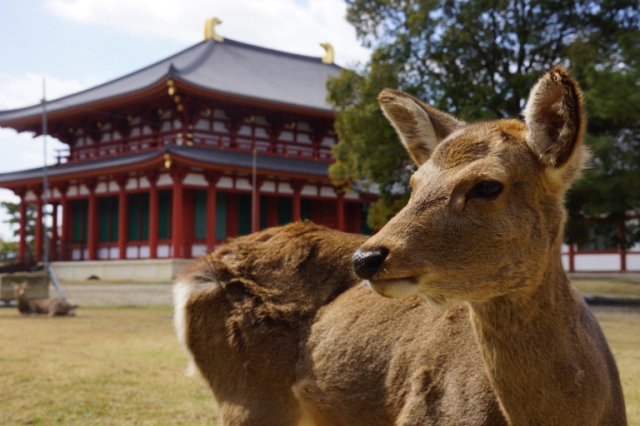
Pretty much everyone who visits Nara stops by the park to feed crackers to the deer, so are the smaller crowds leaving them hungry?
Tourism numbers are down across Japan since the start of the coronavirus outbreak, but the effect has been especially severe in central Japan. An especially large portion of the international travelers who visit the cities of Kyoto and Nara come from China, and with the coronavirus epidemic originating in Wuhan, Japan’s two former capitals have been seeing smaller crowds for roughly two months now.
It’s not just hotels, restaurants, and temples that are receiving fewer visitors, either. Nara’s biggest tourist draw is Nara Park, the expansive green space in the city center that’s home to herds of dear who freely roam the grounds. Vendors in the park sell “shika senbei,” special rice crackers visitors feed to the deer, but fewer visitors means fewer deer cracker customers. That’s making many people to worry about whether or not the deer are in danger of going hungry, especially since the animals have recently been spotted in parts of the city where they’re not such a common sight.
▼ Shika senbei
To check on how her four-legged friends are faring, last week our Japanese-language reporter and Nara resident K. Masami headed over to the park. Sure enough, there were fewer people than normal for this time of year, with the drop in non-Japanese park-goers especially noticeable. However, that park wasn’t empty. Back in her student days, before the international Japan travel boom really got into full swing, Masami used to work part-time at a nearby temple, and on her recent visit she estimates there were still more people in the park than you’d have found on an off-season midwinter day 10 years ago.
As for the deer, they didn’t look particularly distressed as they relaxed in the sun. Still, after finding a vendor, Masami paid the going-rate 200 yen (US$1.90) for a pack of deer crackers and held a disc out to one of the animals…
…who promptly trotted over and ate it.
This left Masami a little confused. The deer looked healthy enough to her, but it hadn’t hesitated to partake of the cracker. Did that mean it was hungry, or is it just standard animal nature to eat whenever the opportunity presents itself?
Being a Nara resident doesn’t grant you the power to telepathically communicate with deer, though, and so Masami couldn’t ask them directly.
▼ Or perhaps she is able to mind meld with them, but they’re too polite to think-talk while they’re eating.
Who Masami could ask, though, was the Nara Deer Preservation Foundation, the city’s local animal welfare group. So she called them up, and asked if the park’s deer are in discomfort or danger as a result of getting fewer shika senbei these days.
The foundation’s answer?
“The deer are accustomed to regularly finding their own food. The shika senbei are essentially snacks for them, so we believe they’re still getting plenty of nutrition these days.”
In retrospect, it makes a lot of sense. While Nara Park’s deer are tame, in the sense that they’re relatively calm and used to being around people, they are still wild animals. No one puts them in enclosures at night or sets out bowls of food and water for them, and while they enjoy the crackers as tasty treats, they’re not a critical necessary part of the animals’ diet. If anything, the association told us the deer might actually be enjoying the smaller crowds, making the park a quieter, less potentially stressful environment than it otherwise would be.
So don’t worry about Nara Park’s deer. They’re doing just fine.
Related: Nara Deer Preservation Foundation
Photos ©SoraNews24
[ Read in Japanese ]


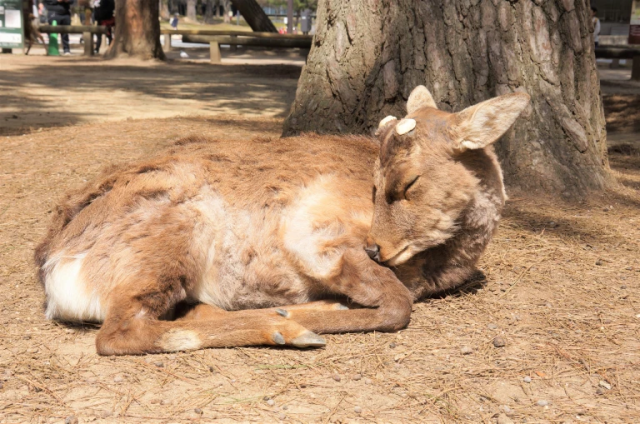
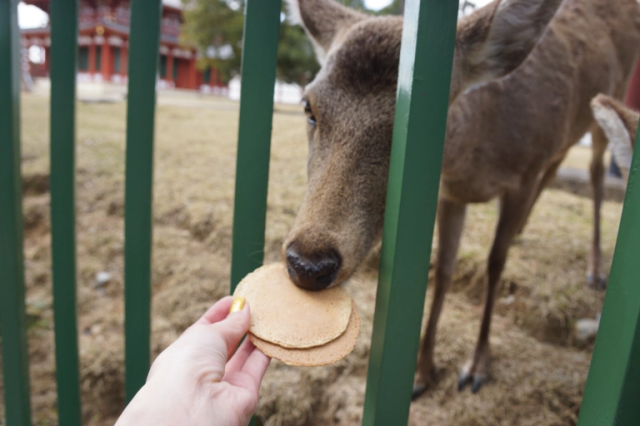
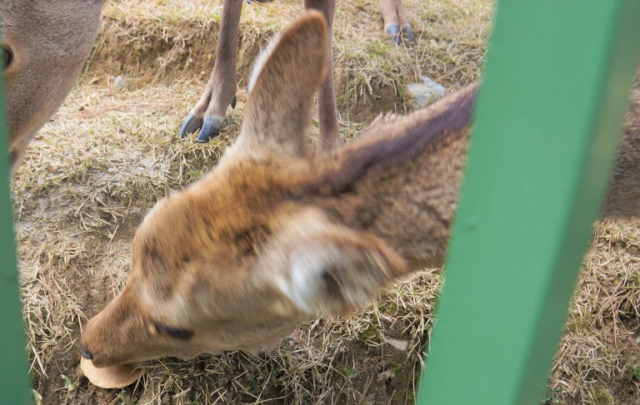
 The poo from Nara Park’s deer is changing because of the coronavirus pandemic
The poo from Nara Park’s deer is changing because of the coronavirus pandemic Increased tourist numbers in Nara Park are affecting the size of its deer population
Increased tourist numbers in Nara Park are affecting the size of its deer population Deer in Nara Park outnumber visitors, display baffling summer gathering behaviour
Deer in Nara Park outnumber visitors, display baffling summer gathering behaviour Nara asks visitors to stop feeding the deer
Nara asks visitors to stop feeding the deer Nara deer shikadamari mystery deepens as tourists return to Nara park
Nara deer shikadamari mystery deepens as tourists return to Nara park Majority of Japanese mayors say foreign residents are essential but most see good and bad effects
Majority of Japanese mayors say foreign residents are essential but most see good and bad effects Japanese beef bowl chain Sukiya’s 2026 Smile Box lucky bag basically pays for itself
Japanese beef bowl chain Sukiya’s 2026 Smile Box lucky bag basically pays for itself Four Shinto shrines to pray for love at in Japan to start the New Year
Four Shinto shrines to pray for love at in Japan to start the New Year We found possibly the quietest Japanese-style hotel in Tokyo’s bustling Shinjuku district
We found possibly the quietest Japanese-style hotel in Tokyo’s bustling Shinjuku district 200 Years Old And Still Irresistibly Adorable! A Timeless Image of “Cute” From the Edo Period
200 Years Old And Still Irresistibly Adorable! A Timeless Image of “Cute” From the Edo Period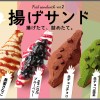 Fried sandwiches arrive in Tokyo, become hot topic on social media
Fried sandwiches arrive in Tokyo, become hot topic on social media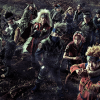 Cast of this summer’s live-action Naruto stage play looks more awesome than ever in new photos
Cast of this summer’s live-action Naruto stage play looks more awesome than ever in new photos Japanese group to hold fashion show of colostomy bags and other stoma equipment in Paris
Japanese group to hold fashion show of colostomy bags and other stoma equipment in Paris McDonald’s Japan is now adding to my giant pile of home delivery junk mail
McDonald’s Japan is now adding to my giant pile of home delivery junk mail Starbucks Japan unveils new Christmas goods, drinkware and candles for the 2025 holiday season
Starbucks Japan unveils new Christmas goods, drinkware and candles for the 2025 holiday season Starbucks Japan ready to get Year of the Horse started with adorable drinkware and plushies【Pics】
Starbucks Japan ready to get Year of the Horse started with adorable drinkware and plushies【Pics】 Hayao Miyazaki says Happy New Year to Studio Ghibli fans with new art for Year of the Horse
Hayao Miyazaki says Happy New Year to Studio Ghibli fans with new art for Year of the Horse 7 great places to see Mt. Fuji from without having to climb it
7 great places to see Mt. Fuji from without having to climb it Cup Noodle tries an authentic Jiro-style ramen, but something’s not quite right
Cup Noodle tries an authentic Jiro-style ramen, but something’s not quite right Hello Kitty Choco Egg figures are an adorable trip through three periods of Japanese pop culture【Pics】
Hello Kitty Choco Egg figures are an adorable trip through three periods of Japanese pop culture【Pics】 Japan’s oldest largetooth sawfish in captivity back on display in Mie Prefecture
Japan’s oldest largetooth sawfish in captivity back on display in Mie Prefecture Cyberpunk anime meets traditional culture in Ghost in the Shell gold leaf Japanese changing screens
Cyberpunk anime meets traditional culture in Ghost in the Shell gold leaf Japanese changing screens The best Starbucks Japan Frappuccinos we want to drink again in 2026
The best Starbucks Japan Frappuccinos we want to drink again in 2026 We revisited Sweets Paradise after a decade to see if Japan’s dessert buffet still delivers
We revisited Sweets Paradise after a decade to see if Japan’s dessert buffet still delivers 7-Eleven Japan starts new temporary luggage storage service in over 300 branches
7-Eleven Japan starts new temporary luggage storage service in over 300 branches Disillusionment at Tsukiji’s tourist-target prices led us to a great ramen restaurant in Tokyo
Disillusionment at Tsukiji’s tourist-target prices led us to a great ramen restaurant in Tokyo Starbucks teams up with 166-year-old Kyoto doll maker for Year of the Horse decorations【Photos】
Starbucks teams up with 166-year-old Kyoto doll maker for Year of the Horse decorations【Photos】 Tokyo considering law requiring more trash cans following litter increase in heavily touristed area
Tokyo considering law requiring more trash cans following litter increase in heavily touristed area Tokyo’s Tsukiji sushi neighborhood asks tour groups to stay away for the rest of the month
Tokyo’s Tsukiji sushi neighborhood asks tour groups to stay away for the rest of the month Tokyo event lets you travel back in time, for free, to celebrate 100 years since Showa era start
Tokyo event lets you travel back in time, for free, to celebrate 100 years since Showa era start Sanrio theme park in Japan announces plans to expand into a Sanrio resort
Sanrio theme park in Japan announces plans to expand into a Sanrio resort Japan may add Japanese language proficiency, lifestyle classes to permanent foreign resident requirements
Japan may add Japanese language proficiency, lifestyle classes to permanent foreign resident requirements Stamina-destroying “Paralysis Noodles” are Tokyo’s newest over-the-top ramen innovation
Stamina-destroying “Paralysis Noodles” are Tokyo’s newest over-the-top ramen innovation Survey asks foreign tourists what bothered them in Japan, more than half gave same answer
Survey asks foreign tourists what bothered them in Japan, more than half gave same answer Japan’s human washing machines will go on sale to general public, demos to be held in Tokyo
Japan’s human washing machines will go on sale to general public, demos to be held in Tokyo Japan’s deadliest food claims more victims, but why do people keep eating it for New Year’s?
Japan’s deadliest food claims more victims, but why do people keep eating it for New Year’s? We deeply regret going into this tunnel on our walk in the mountains of Japan
We deeply regret going into this tunnel on our walk in the mountains of Japan Studio Ghibli releases Kodama forest spirits from Princess Mononoke to light up your home
Studio Ghibli releases Kodama forest spirits from Princess Mononoke to light up your home Major Japanese hotel chain says reservations via overseas booking sites may not be valid
Major Japanese hotel chain says reservations via overseas booking sites may not be valid Put sesame oil in your coffee? Japanese maker says it’s the best way to start your day【Taste test】
Put sesame oil in your coffee? Japanese maker says it’s the best way to start your day【Taste test】 No more using real katana for tourism activities, Japan’s National Police Agency says
No more using real katana for tourism activities, Japan’s National Police Agency says Starbucks Japan reveals new sakura drinkware collection, inspired by evening cherry blossoms
Starbucks Japan reveals new sakura drinkware collection, inspired by evening cherry blossoms Updated cherry blossom forecast shows extra-long sakura season for Japan this year
Updated cherry blossom forecast shows extra-long sakura season for Japan this year This Nara workshop has been making deer crackers for more than 100 years and offers tours【Photos】
This Nara workshop has been making deer crackers for more than 100 years and offers tours【Photos】 Nara unveils new vending machines that sell deer crackers
Nara unveils new vending machines that sell deer crackers Nara deer shikadamari phenomenon continues to baffle visitors at Nara park
Nara deer shikadamari phenomenon continues to baffle visitors at Nara park Nara deer “addicted” to rice crackers, lose weight with no tourists to feed them
Nara deer “addicted” to rice crackers, lose weight with no tourists to feed them Nara’s “deer cookie” rice crackers get their first price increase in 28 years
Nara’s “deer cookie” rice crackers get their first price increase in 28 years Shikayose: The Calling of the Deer in Nara with acorns and a French horn
Shikayose: The Calling of the Deer in Nara with acorns and a French horn Deer in Nara Park mysteriously disappear during this year’s shikadamari season
Deer in Nara Park mysteriously disappear during this year’s shikadamari season Record number of people injured by deer in Nara this year
Record number of people injured by deer in Nara this year Bizarre “shikadamari” deer gathering at Nara Park baffles people in Japan
Bizarre “shikadamari” deer gathering at Nara Park baffles people in Japan Nara deer heading farther outside park during the coronavirus outbreak, but will they come back?
Nara deer heading farther outside park during the coronavirus outbreak, but will they come back? Shikadamari: The Nara deer summer gathering phenomenon that baffles visitors every year
Shikadamari: The Nara deer summer gathering phenomenon that baffles visitors every year Nara deer leave park, head to station for food as tourist numbers tumble due to coronavirus
Nara deer leave park, head to station for food as tourist numbers tumble due to coronavirus Video of man kicking, slapping deer in Nara Park outrages Japan【Video】
Video of man kicking, slapping deer in Nara Park outrages Japan【Video】 Deer killed by man with axe in Nara
Deer killed by man with axe in Nara A senbero with deer in Nara Park turns into a weird fever dream
A senbero with deer in Nara Park turns into a weird fever dream Locals (deer) shut visitors out of Nara Park cool-down misting station【Video】
Locals (deer) shut visitors out of Nara Park cool-down misting station【Video】
Leave a Reply